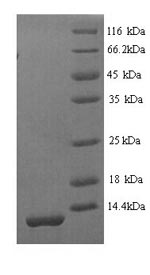This Recombinant Mouse Spink1 is a recombinant protein product meticulously designed to support your scientific inquiries. This product embodies the full-length mature form of P12, alternatively known as Prostatic Secretory Glycoprotein or Serine Protease Inhibitor Kazal-type 3. It's derived from mouse species and generated through a yeast expression system, furthering its utility in a variety of research contexts.
The protein of interest spans from the 24th to the 80th amino acid region, making it an exact representation of the mature form. It features an N-terminal 6xHis-tag, which enhances its visibility and ease of purification in experimental processes. The product's purity exceeds 90% as confirmed by SDS-PAGE, ensuring its consistency and reliability. Depending on your experimental needs, you can opt for the Recombinant Mouse Spink1 in a liquid or lyophilized powder form.






